By Chris Mc Loone and FA&EE Advisory Board
FDIC International is a busy time, and looking back to come up with one central theme pervading the entire show isn’t easy. Innovation is always a huge part of the show both on the equipment side and the apparatus side, but I heard from more than one manufacturer that the historic backlogs are really getting most of their attention currently.
Resources are being directed to really dig into the backlog to continue catching up. The COVID-19 Pandemic was a learning experience for us all, and manufacturers learned quickly that alternative sources for parts and materials are critical if something like that comes up again.
Electric vehicles continue to be a focus for several manufacturers—both fire apparatus and ambulances. Apparatus and ambulance OEMs develop their electric vehicles to ensure that they are offering what their customers are calling for. It reminds me of a commercial I saw recently from an automobile company that basically said (paraphrasing): “Do you want a vehicle with an ICE? Do you want a hybrid? Do you want an electric vehicle? We make them all.” And really, that’s what our OEMs are doing: providing vehicles for us based on our needs.
Battery-operated equipment is not limited to vehicles or power tools or ventilation fans. One company had a mobile air trailer with a battery-operated compressor. We will continue to see batteries power more and more of our equipment. While this equipment will not be for every fire department, battery-powered units continue to show up on the FDIC International show floor.
Fire Apparatus & Emergency Equipment asked its Advisory Board members to share what was noteworthy to them at FDIC International 2024 and what they saw. Following are their impressions from the show floor.
Cab Interior Equipment Restraints
BY CHRIS DALY
During this year’s walk-about on the FDIC show floor, I did my usual survey for vehicle safety equipment. I soon found myself checking out the IMMI SmartDock system (photo 1). The SmartDock system is a restraint system for self-contained breathing apparatus (SCBA) that will lock air packs in place during a crash. The SmartDock system meets National Fire Protection Association (NFPA) 1900, Standard for Aircraft Rescue and Firefighting Vehicles, Automotive Fire Apparatus, Wildland Fire Apparatus, and Automotive Ambulances, Section 11.1.10 for cab safety while allowing the firefighter to easily exit the seat while wearing the SCBA during normal operations. This system is a good reminder for fire departments that it is important to restrain all loose equipment in the cab of the vehicle, not just the SCBA. While required by the NFPA standard, common sense also dictates that if a fire apparatus is involved in a crash, any loose equipment inside the passenger compartment could become a dangerous projectile that could seriously injury or even kill a firefighter. In addition to loose equipment posing a problem, so does a loose firefighter. So, buckle up!
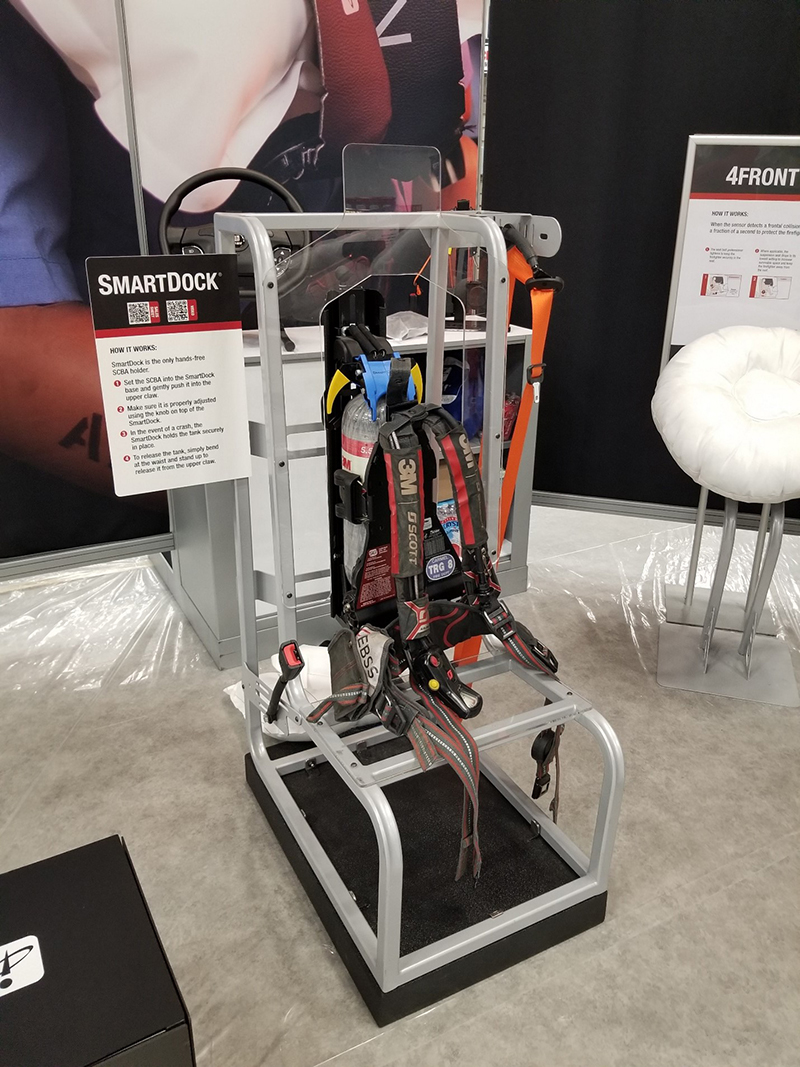
1
Noteworthy Products at FDIC 2024
BY ROBERT TUTTEROW
FDIC International 2024 had an abundance of new products and new product improvements. Here is a sampling of a few items that caught my attention.
Two apparatus were particularly noteworthy. I was impressed with the Pierce heavy rescue unit for the Walkersville (MD) Volunteer Fire Department. It was a tandem axle rig with rear axle steer added, a pump and booster tank, a separate heated tank for gross decon, four awnings, and more. The eye catchers for me were the two Roto-Rays on the front. As Bob Barraclough once said, you could tell that truck was designed by a committee, and everyone got what they wanted.
The other apparatus was a European-style electric pumper for Vancouver (British Columbia, Canada) Fire Rescue Services by Rosenbauer. Although it looked European at first glance, I would suggest it was a hybrid European/North American style apparatus because it had a hosebed, which is not on European rigs. The spacious cab, with a skylight, combined with the ability to lower the entire truck close to ground for easy entrance/egress, was most impressive. From the ground, a simple 8-inch step up, and you are in the cab.
We are all aware of the challenges of maximizing compartment space. The FirstGard folding traffic cone from PSS-Innovations is a smart solution. Five of these 28.75-inch-high folding cones take up no more space than one traditional style cone. The cones are robust and conform to the Manual for Uniform Traffic Control Devices.
Carna Bunker Gear introduced “carcinogen-free training gear.” With the emphasis on minimizing the wear of NFPA-compliant structural gear by only wearing it for structural firefighting, the Carna Bunker Gear provides an alternative. It is made of cotton-duck and is perfect for wearing when training—except for training evolutions involving live burns. It is a very effective way to minimize exposure to probably contaminated compliant structural gear and extend the life of compliant gear.
Speaking of contamination, Safety Lab Plus offers testing kits to fire departments to test the effectiveness of their decontamination processes. Departments simply take samples from their gear and send them to the company for analysis. And, it also offers sample kits for departments to send station air or apparatus cab air samples for analysis. The company is fully accredited with ISO 17025:2017.
The contamination discussion does not always give proper attention to viruses and bacteria. Cres Guard displayed equipment designed to kill these harmful agents. Not only was it showing equipment for structural personal protective equipment (PPE), but also had units that could clean electronic equipment. Both units were portable, run on 110 VAC, and were about the size of a small refrigerator. And, AeroClave was offering a portable disinfection package that can be a hands-free operation for disinfecting a room or used in a handheld mode for the interior of a cab or ambulance.
Other air filtration equipment included cab filtration and station filtration units by Task Force Tips (TFT) and Toxic Suppression. The TFT units come with a simple air quality indicator that changes color when there is an issue. The Toxic Suppression units come with software that constantly monitors air and provides real-time information through a computer dashboard. Air quality in cabs and fire stations is clearly an emerging concern that firefighters must address.
Another product enhancement that I found appealing was called Gription. It is a slip-resistant tape made in various widths for applying to tool handles to improve grip. This can range from hammers to axes. In addition, the tape can be applied to steps and other standing surfaces to improve slip resistance. The product is distributed by Darley.
Plethora of Fire Apparatus and Ambulances Fills the Expo Floor at FDIC 2024
BY ALAN M. PETRILLO
KME featured a PRO® pumper built for the Napanoch (NY) Fire District on a KME XLFD four-door cab with 4Front frontal impact and RollTek rollover air bag safety systems carrying a Hale DSD 1,500-gallon-per-minute (gpm) pump and a 500-gallon water tank, while Ferrara Fire Apparatus exhibited Cinder custom pumpers for the Prairieville (LA) Fire Department (2,000-gpm Waterous CSU pump, 1,000-gallon water tank, 30-gallon foam tank) and the White River Township (IN) Fire Department (Hale 1,750-gpm Qmax XS pump, 1,000-gallon water tank).
E-ONE, celebrating its 50th year in business, exhibited a Metro 100 Quint for the Fairfield (OH) Fire Department on a Typhoon cab and chassis with an aerial tip load of 500 pounds wet or dry and carrying a Hale DSD 1,500-gpm pump, a 430-gallon water tank, a 20-gallon foam tank, and a Class 1 2.1A foam system. Spartan Emergency Response showed a 105-foot tractor-drawn aerial (TDA) built for the Savannah (GA) Fire Department on a Spartan Gladiator ELFD cab and chassis with a 10-inch raised roof. The rig features storage for 268 feet of ground ladders and a Harrison 10-kW generator.
Pierce Manufacturing displayed several aerial apparatus, including a 107-foot Ascendant rear-mount aerial ladder quint for the U.S. Navy Norfolk (VA) with a 2,000-gpm Waterous CSU pump, a 500-gallon water tank, a 20-gallon foam cell, and a TFT Flex monitor as well a Volterra electric pumper.
Rosenbauer had an array of rigs displayed, including the RTX electric pumper built for Vancouver (BC) Fire Rescue Services with a Rosenbauer 1,500-gpm N series pump, a 500-gallon water tank, and a 1,250-gpm roof turret.
Sutphen displayed pumpers, quints, and aerials, including a TDA quint for the Huber Heights (OH) Fire Department with a Qmax 1,500-gpm pump, 300-gallon water tank, and nearly 600 cubic feet of compartment space.
REV Ambulance Group’s Wheeled Coach exhibited a Type 1 Texas Edition ambulance for the Laredo (TX) Fire Department on a Dodge 4500 4×2 chassis, with LiquidSpring® rear suspension, all-aluminum interior cabinetry, locking drug box, Vanner LifeSine® inverter/charger, and Zico slide-and-flip-out oxygen storage.
Road Rescue showed a Type 3 Ultramedic for Hennepin (MN) EMS that has an emergency room-inspired design as a rolling trauma unit with angled cabinets, extra open space, and an Aeroclave disinfectant system.
American Emergency Vehicles displayed a pediatric critical care transport unit for St. Louis Children’s Hospital on a Freightliner chassis and four-door crew cab that has an arctic animal theme, dual 125-volt air conditioning/heating systems, and Halo interior lighting.
Horton Emergency Vehicles showed a Type 1 ambulance for the Broken Arrow (OH) Fire Department that features HiViz FireTech LED warning lights and has interior medic protection by the Horton Occupant Protection System (HOPS) with MBrace.
W.S. Darley& Company introduced the Electro FS12, a four-stage high-pressure electric portable pump powered by a 146-kW battery that provides a one-hour run time on a seven-hour charge and flows 30 gpm at 350 pounds per square inch (psi) and 100 gpm at 150 psi.
MSA Cairns introduced its new MSA Cairns® 1836 Fire Helmet that has a reduced ride height; a slide-lock system to eliminate special tools for disassembly; an articulating integrated Defender® Visor with optional NFPA-compliant Bourkes eye shield, a 4-inch face shield, and ESS goggles as options; a pivoting ratchet and headband with three adjustable positions; and laser-etched product and certification information, eliminating the need for labels.
Electric Rigs and CAFS
BY RON HEAL
This FDIC saw three customer-ordered electric fire apparatus, one each for Toronto, Vancouver, and Victoria. Spartan Emergency Response featured the Toronto pumper. Rosenbauer had the units for Victoria and Vancouver. Rosenbauer had its RXT Range Extended Electric Vehicle in the outside exhibit area. Pierce Manufacturing also had its Volterra electric pumper at its booth.
There was an impressive Patriot model Blanchat Manufacturing Wildland Interface Engine built for Yoder, Wyoming. Greg Blanchat, president of Blanchat Manufacturing, has worked for many years to develop a compressed air foam system (CAFS) that meets all 15 of his system standards. The Blanchat Accelerator-Controller is his system that he calls a Force Multiplier System. Some of the standards include being user-friendly, instant CAFS, flow control, mixture control, ability to alternate between CAFS and water, stream recall, and reliability. Blanchat refers to his system as CAFS 2.0. He has conducted several successful demonstrations using the Accelerator-Controller. One demonstration involved fighting a fire involving 16 vehicles filled with tires using 600 gallons of water and dish soap to create a foam solution. This system can be ordered on new apparatus or can also be added to units already in service.
New and Existing Players
BY BILL ADAMS
After an involuntary hiatus from the show circuit, I looked forward to this year’s FDIC International. It wasn’t disappointing. As educational as it was to assess the new apparatus, observing the interactions between the attendees and vendors was equally interesting. The atmosphere from booth to booth varied as much as listening to fire service gossip and industry rumors.
The best rig on the floor? Give participation trophies to all of them. They all looked good. Two that I found very interesting were intricately designed and very complex heavy rescues—probably 40-footers on tandem custom cabs and chassis. A Pierce was headed for Walkersville in Frederick County, Maryland, and an SVI Trucks was going to Vander in Fayetteville, North Carolina. I thought staffing issues and multifunction apparatus such as quints, rescue-pumpers (or pumper-rescues), and pumper-tankers would have led to the demise of big rescues.
There appear to be new players in the North American fire apparatus marketplace. Tucked between two major domestic apparatus manufacturers was a rig self-advertised as a wildland mini pumper, a Type 3 wildland, and a Type 1 pumper. The space was assigned to Iturri America, Inc. Iturri is a multifaceted safety-orientated Spanish organization operating in 14 countries with several thousand employees. One of its divisions builds fire trucks.
Mexican manufacturer Quiroga Fire Trucks has been around for more than 40 years and has previously displayed at FDIC. Interestingly, the rig shown this year was built on a Scania four-door cab and chassis. Scania is a large Swedish commercial cab and chassis manufacturer commonly used by many off-shore apparatus manufacturers. It looked like a custom. Quiroga also builds on American-made custom cabs and chassis.
It is unknown if our recent domestic pandemic, employment problems, and supply chain issues have affected off-shore fire apparatus manufacturers. However, one’s Web site claims that 40% of its apparatus component parts come from the United States. Large-diameter hose, sexless couplings, rear-mounted aerial ladders, fully enclosed cabs, and even electric fire trucks did not originate in America. I tend to believe we make them better!
Hy-Conn: Saving Valuable Time on Fire Scenes
BY BILL ADKINS
FDIC International 2024 has come and gone, and what a show it was. Every year I make it a point to find a product that I’ve never seen before. This year I found that product in Lucas Oil Stadium.
Hy-Conn (photo 2) is an adapter used to make hydrant connections faster and more efficient—reducing the time to make a hydrant connection from upward of 30 to 40 seconds to just three seconds. When connecting to a hydrant with threads, the Hy-Conn adapter uses a thread that is slightly larger than the threads of the hydrant. The larger threads are gapped with stainless steel springs and allow for the adapter to slide over the hydrant thread. With a quarter turn, the threads reduce in size and secure to the hydrant and are protected by two locks.

2
Hy-Conn is designed in accordance with NFPA 1963, Standard for Fire Hose Connections, and is rated at 250 psi. These adapters are tested at 1,000 psi for 1,000 cycles. Foreign debris and drop testing are other ways Hy-Conn ensures its adapters are safe for firefighter use. Adapters are machined from 6061/T651 billet aluminum. The threaded inserts are coated with Black-T to eliminate the need for lubrication on any of the moving parts. Current adapters come in 4½-, 2½-, and 1½-inch configurations and come standard with national standard threads (NST). Hy-Conn claims it can custom fit any thread type, that the adapters come with your choice of lugs or handles, and that there is no reduction of flow from the hydrant.
Intake Valve with 3,000-gpm Flow Rate
BY ANDY SOCCODATO
FDIC 2024 was an extremely exciting year with regard to water supply equipment. Most notably, Elkhart Brass introduced a new external intake valve, the XD Intake Model 1902 (photo 3). Previously, the only external intake valve available from Elkhart Brass was a piston-intake style valve. While the piston-intake valve has lasted several decades in the American fire service, it’s design severely limits the flow rate available to the pumping apparatus—especially when used in conjunction with a drafting operation.
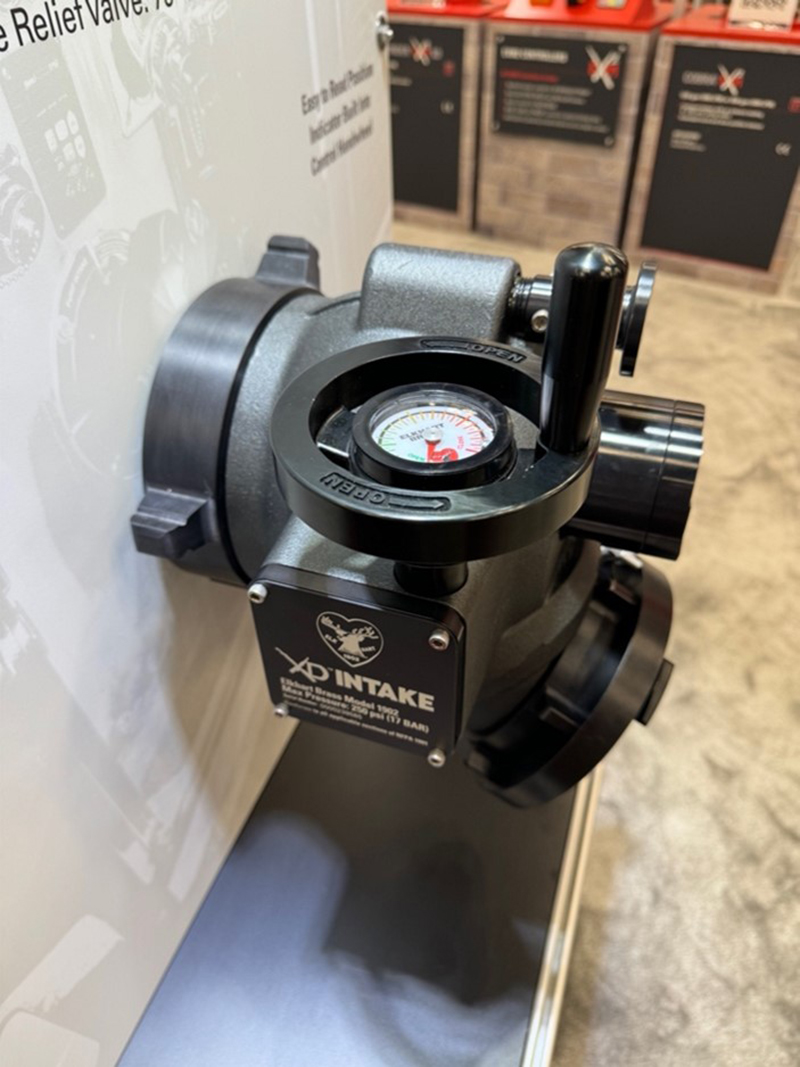
3
Recognizing the fire service’s desire to feed pumping apparatus with larger volumes of water while maintaining functionality and efficiency, Elkhart Brass developed the XD Intake Model 1902. This external intake valve is equipped with a 5.12-inch unobstructed waterway that is designed for full flow into the pump. Customers can purchase this valve in either a straight or low-profile configuration. Additionally, customers can outfit the straight version with a 30-degree turn-down spout to make connecting hose easier for firefighters.
Regardless of configuration, the valve is designed and rated to flow 3,000 gpm. During the testing phase of the valve, both the straight and low-profile valves were tested to determine the internal friction loss through the waterway at a 3,000-gpm flow rate. Both versions tested were equipped with a 6-inch NST inlet and a 6-inch NST outlet. The low-profile version of the XD Intake Model 1902 can flow 3,000 gpm with only 12 psi of loss. The straight version of the XD Intake can flow the same 3,000 gpm with only 2 psi of internal loss.
During testing of the XD Intake straight version, the valve could draft 1,452 gpm before the pumper reached cavitation. This test was performed using 20 feet of 6-inch hard sleeve and with approximately 5 to 6 feet of lift. In my opinion, this makes the straight version of the XD Intake Model 1902 a fantastic option for fire departments who routinely draft and desire to have control of the water entering their pump.
Another feature of the XD Intake is the built-in bleeder valve configuration located at the top of the valve body casting. The bleeder control features a push/pull style actuator that makes it easy for the operator to bleed the air in the supply line connected to the intake. Even more exciting is that the bleeder valve assembly has two exhaust ports that allow air to be rapidly expelled from the system. If customers do not wish to have water expel from both sides of the bleeder assembly, one side can be plugged. The remaining single bleeder opening will still meet the NFPA 1900 requirement for the minimum bleeder size. In addition, if the fire department does not want water to be expelled right at the top of the valve, a hose nipple can be installed in the bleeder port to allow a flexible drain hose to redirect the water away from the operator.
The control handle for the intake valve is a hand wheel with a top-positioned indicator that shows the operator the valve position status. This handle position is ideal for pump panels that are behind roll-up doors because it will not cause the valve footprint to encroach past the clear door opening. Another major advantage of this intake valve is that the operating mechanism contains a gear reduction system that makes opening and closing the intake under pressure almost effortless. The control handle and mechanism can be mounted on either the right- or left-hand side of the valve body to meet the space requirements of any pump panel.
Tools to Make Our Jobs More Efficient
BY RAUL ANGULO
Manufacturers and firefighter inventors are still at it, developing tools and accessories to make our job and efforts more efficient, effective, and safer. For example, a Seagrave 100-foot aerial (photo 4) is lit up with bright LED lights encased in a durable protective cover. The lights illuminate the rungs and the rails without blinding the firefighter climbing the ladder. Even on the show floor, it noticeably lit up the rungs and rails of the ladder in bright neon green. Those of us who have worked on ladder trucks know the top two sections can often be obscured in thick smoke from the fire or fog from inclement weather. The aerial ladder to the roof is our primary access and egress for escape. It only makes sense to light it up.
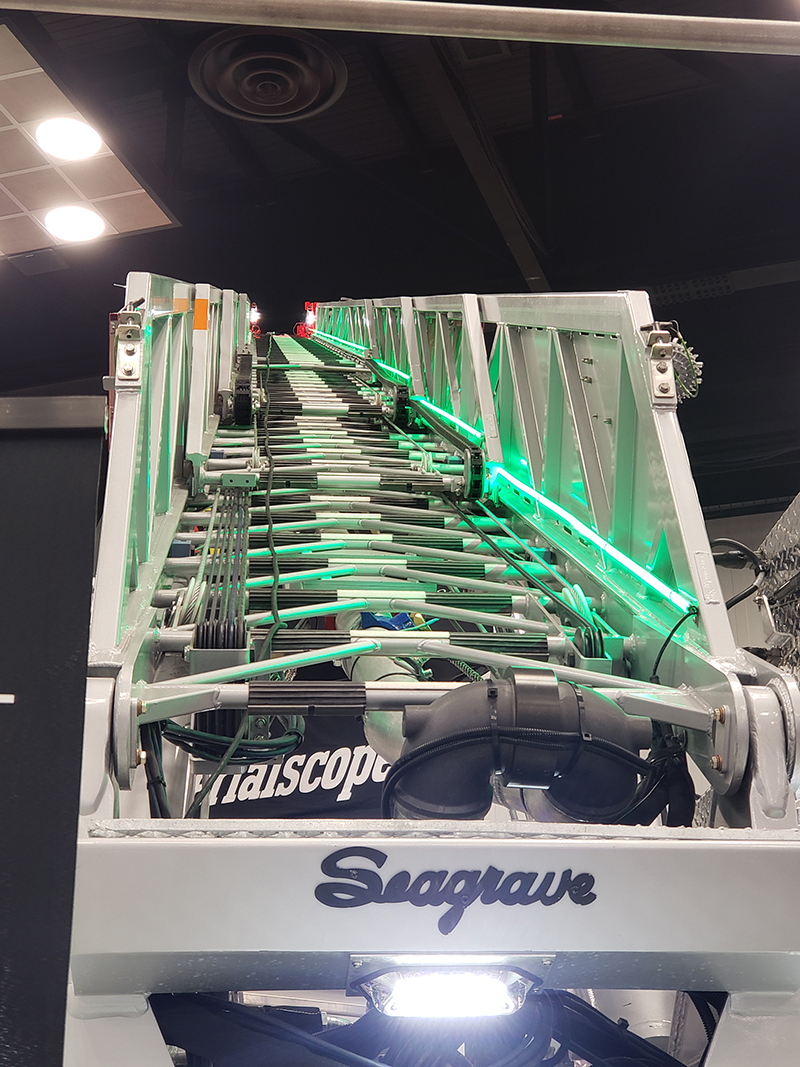
4
One of the international vendors at FDIC was Tohatsu from Tokyo, Japan. It manufactures portable fire pumps that can draft water or work off a hydrant supply. Model VE1500 has a maximum flow rating of 542 gpm, and the VE1000 has a maximum flow rating of 502 gpm. Model VF63AS-R has a maximum flow rating of 304 gpm. The VC52AS has a maximum flow rating of 343 gpm, and the VC72AS (photo 5) has a maximum flow rating of 409 gpm. The VE500AS and the VF21BS both have a maximum flow rate of 500 gpm. All the flow rates were calculated from a 9.8-foot draft suction, and all the Tohatsu portable fire pumps can draft up to 30 feet.
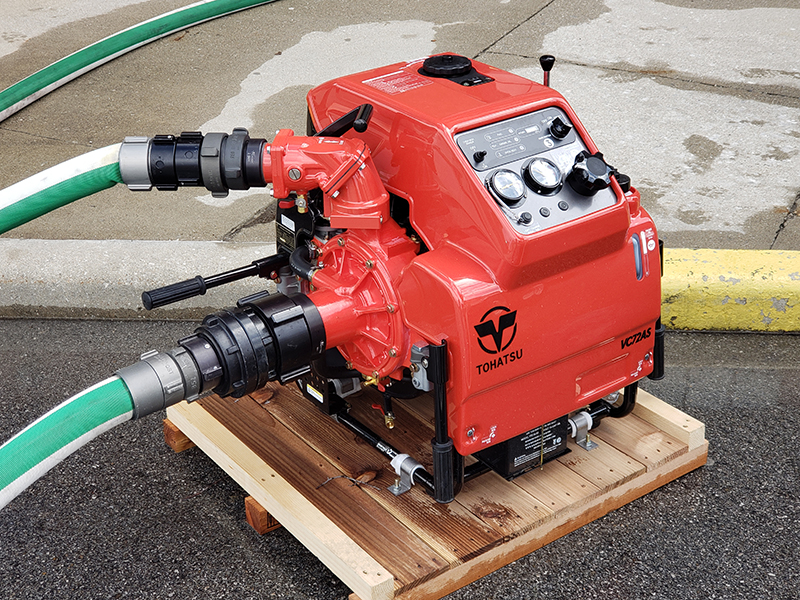
5
The Drago Spider (photo 6) “fan cannon” nozzle is a water delivery and vaporization extinguishing system by Drago ISI out of Quebec, Canada. A giant fan, similar to a positive pressure mobile ventilation unit (MVU), combines air and water under pressure to flow through the Spider nozzle. There are three types of Spider nozzles: high-pressure, medium pressure, and low-pressure. The 14-16 nozzle heads and deflectors (depending on the unit) break up the water stream into fine droplets and mist particles. The fan introduces a moisture-saturated pressurized flow path that can be directed into the burning structure. The vaporized flow path must be directed and controlled. Maximum flow rate is 785 gpm and stream distance exceeds 200 feet.
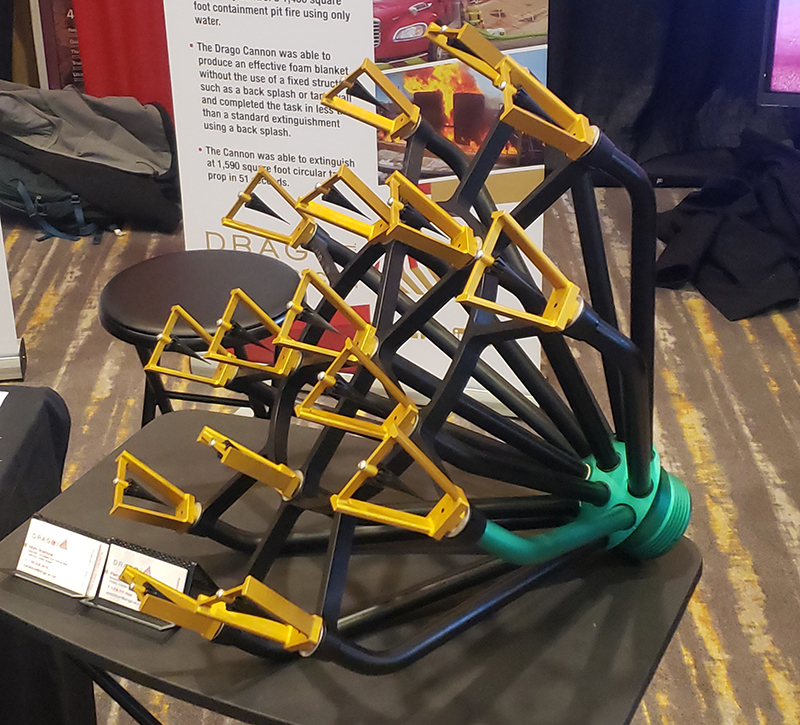
6
The HEN BLADE Nozzle (photo 7) is an adjustable smooth bore nozzle that switches from a solid stream to a solid inline flat blade or “fan” pattern with a quarter turn of the rubber bumper stream adjuster. The HEN Turbo-25 (photo 8) is a hose backpressure increaser coupling that attaches to the 1½-inch male threads at end of the fire hose before attaching the nozzle. The Turbo-25 increases the backpressure by an additional 30 to 35 psi in the handline stretch for 150- to 185-gpm nozzles. The coupling “turbocharges” the performance of a 1¾-inch hoseline when using a 50-psi nozzle. It also allows the driver to pump at 75 psi for other combination nozzles without gating down to accommodate the lower pressure smooth bore nozzle. The HEN Turbo-25 comes in a 25-psi, 1½-inch version with NH or NPSH threads and a 25-psi, 2 ½-inch version with NH or NPSH threads.

7
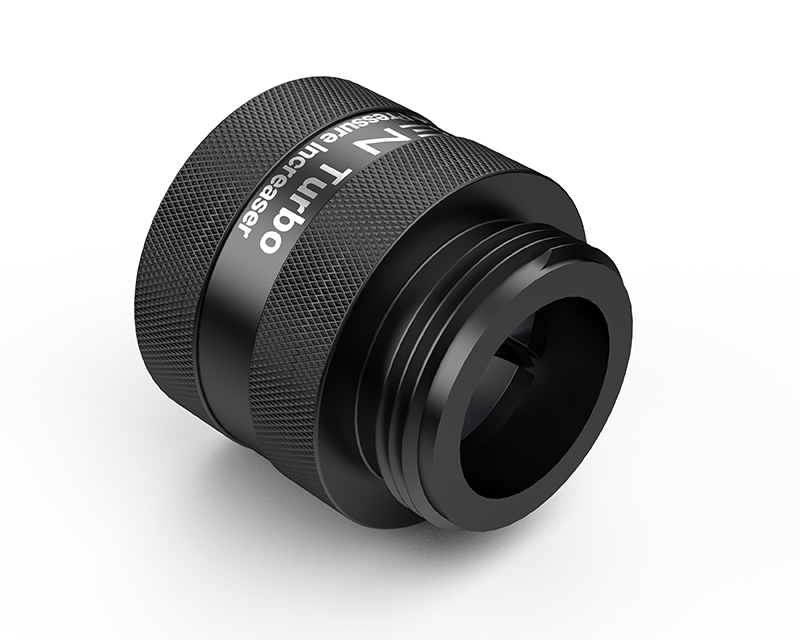
8
Digital Combustion’s Fire Studio 7 is an all-hazard incident simulator that incorporates customer input to improve its software to make everything even more realistic. It added more types of smoke and fire conditions. On the fire end, it added burning building construction components and assemblies like burning beams, burning cross-members, and burning window frames, which allows users to build more technically accurate fire simulations. There are still 20 prepackaged simulations to get users started, but the program is designed so users can import their own photos and videos to build custom simulations that are relevant to their city or geographical areas.

